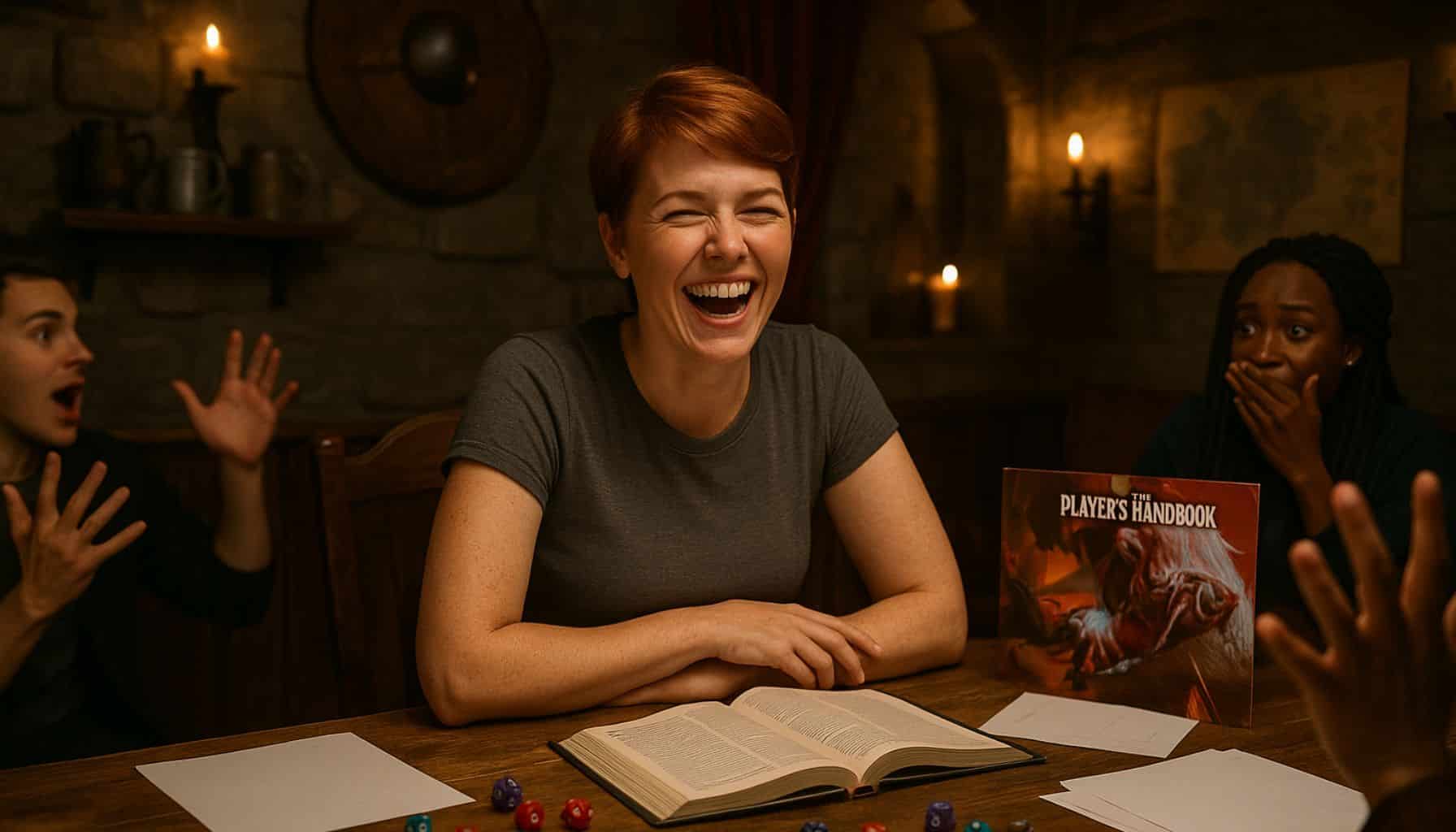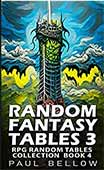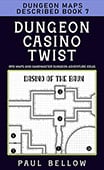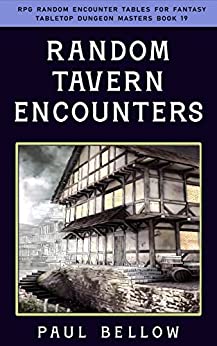Drop your binders and breathe deep: this is not another ode to color-coded notebooks or painstakingly balanced encounter charts. Instead, picture an evening where you arrive at the table armed only with dice, vibes, and a reckless sense of adventure. Zero-prep D&D—yes, truly playing without pre-written adventures, mapped-out dungeons, or a sheaf of lovingly crafted NPCs—embraces disorder as a creative force rather than an obstacle. For many Dungeon Masters, the very thought of improvising a session from scratch induces stomach-churning anxiety. The horror of blank stares, plot holes, or fizzling momentum looms large, conjuring the specter of a floundering, forgettable game.
Yet, in the swirling storm of the unscripted lies the secret ingredient that makes roleplaying sessions unforgettable: spontaneity. Where meticulous plans create corridors, improvisation offers wild, sprawling landscapes. The very act of letting go, of trusting your own creativity and the unpredictable weirdness of your players, can be freeing. No-prep DMing isn’t about winging everything blindly or being too lazy to plan; it’s about giving permission for mutual discovery, for stories that twist and turn in delightfully unexpected ways.
What does “no prep” really mean, though? At its core, it’s the art of showing up with maybe a loose premise or a couple of jotted half-ideas—nothing more. There’s no exhaustive lore bible, no elaborate villain arc already mapped. Instead, you launch the session with the barest scaffolding—a mood, a motif, perhaps a handful of mysterious names rattling around in your head. The world springs to life not before the session, but during it, built collaboratively with your group, moment by moment.
The purpose of diving into no-prep territory isn’t to court disaster or embrace chaos for its own sake. It’s to empower Dungeon Masters—whether weary from burnout or just hungry for a new challenge—to trust themselves, their tablemates, and the process of gaming itself. Improvisational play demands a willingness to respond, adapt, and let go of rigid scripts, but it also promises the sort of wild, alive storytelling that keeps tables laughing, gasping, and eager to return week after week.
Moving from a mindset of total control to one of co-creation transforms the game’s energy. Suddenly, you’re no longer the sole architect shaping every twist and turn. The players aren’t just passengers—they’re co-authors. Prepare to be surprised, delighted, and sometimes even a little unsettled. But above all, get ready to remember why you started playing D&D in the first place: for moments where magic and unpredictability collide. Don’t get us wrong, having great AI RPG tools helps!
The Benefits of No-Prep DMing
The freedom that comes with throwing away your pages of prep cannot be overstated. One of the greatest joys is the real-time collaboration it encourages. Players can sense when the world bends around their choices, rather than feeling like they’re being nudged along invisible rails. Each session becomes a living conversation, where everyone at the table is invested in what happens next not because they’re following breadcrumbs, but because they’re blazing the trail themselves.
Try my AI Tabletop RPG generators...and an extensive library of content!
There’s a special alchemy when stories unfold organically. As a DM, you’re freed from the pressure of “completing the adventure as written.” Instead, you respond to the unexpected with flexibility, adapting to offbeat plans and wild gambits. Not only does this lower the risk of DM burnout, it opens up entirely new avenues for creativity. The improvisational mindset asks, “What if?” and takes player suggestions seriously, often prioritizing their fun over clinging to preconceived outcomes.
Perhaps one of the most underrated upsides is the surprise factor—both for the DM and for the players. When neither side knows exactly what lies ahead, every plot twist feels sharp and genuine. The usual DM poker face dissolves; you get to revel alongside your group in the delight of new revelations, never having to fake shock or feign intrigue. No-prep D&D challenges you to stay nimble, building confidence in your instinctual storytelling skills and honing your sense of narrative rhythm.
Flexibility is the natural enemy of stagnation. Running games off the cuff fosters unique narrative detours that simply wouldn’t exist with rigorous pre-planning. It invites risk, rewards adaptability, and ensures that no two sessions ever feel alike. For DMs hungry for a table buzzing with engaged, inventive players—and for their own sense of adventure—no-prep play can be a refreshing, reinvigorating approach.
15+ Benefits of No-Prep DMing:
- Faster session startup
- No railroading or forced narratives
- Enhanced player agency
- Greater adaptability to player choices
- Authentic surprise for DM and players
- Lower risk of DM burnout
- Heightened creativity for everyone
- Smoother handling of unexpected situations
- Deeper collaborative storytelling
- Less pressure to “get it right”
- Encourages player engagement and ownership
- Easier to introduce new players or ideas
- Reduces workload between sessions
- More room for humor and in-the-moment jokes
- Sessions remain fresh and unpredictable
- Freer pacing—follow the story’s natural flow
- Encourages “yes, and” mentality at the table
- Emphasizes the journey over a set outcome
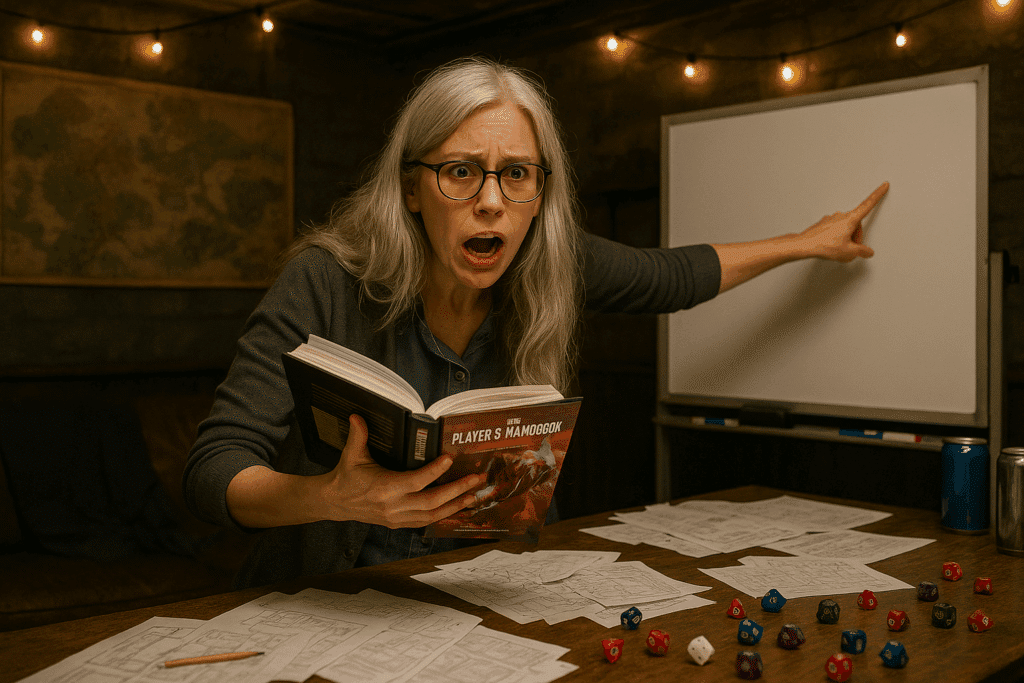
Core Skills for Improvised Play
Flourishing as a no-prep Dungeon Master isn’t a mystical talent; it’s a honed set of skills. First, active listening is foundational. In the midst of banter and dice rolls, tuning in to your players’ words, theories, and throwaway lines allows you to harvest inspiration on the fly. Strong listening means never missing a chance to turn a casual remark into a central plot point or to resurrect an NPC a player cared about but left behind.
⚔️ Fantasy RPG Random Tables Books
Make life as a Gamemaster easier…
If you play Dungeons & Dragons, Pathfinder, or other fantasy RPGs, this
RPG random tables series
is packed with encounters, NPCs, treasure, and more. Available in eBook or print—either way, you’ll have a wealth of adventure ideas at your fingertips.
Creative reframing follows close behind. When a session veers off the rails or characters chase a detail you hadn’t considered, the ability to flip these moments into opportunities—rather than obstacles—keeps the flow alive. Practice twisting surprises into assets, seamlessly weaving disparate ideas into a coherent whole. This is the art of saying yes to the unexpected, building momentum rather than fighting it.
Consistency, both in tone and world logic, becomes your invisible anchor. Without notes or lengthy background text, you must keep a mental ledger of character motivations, established facts, and loose threads. Developing mini-systems—a running tally of names, a few recurring visual motifs—can help you tie impromptu decisions back together as the session unfolds. Confidence is the special sauce that binds it all, because nothing sells a sudden twist or new encounter quite like dropping it with certainty.
How do you build these skills? Practice, experimentation, and a willingness to occasionally fumble in the name of fun. Let yourself riff on player ideas and trust your gut—not every detail needs to be perfect for the table to have an amazing time. Remember, the only real rule is to keep things moving and make sure everyone feels heard and included.
12+ Improv Skills for DMs:
- Naming characters, places, and organizations on the fly
- Describing environments with evocative detail
- Reacting to player ideas with immediate buy-in
- Making callbacks to earlier events for continuity
- Establishing consistent tone and atmosphere
- Flipping throwaway details into plot points
- Adapting to sudden player turns or wild plans
- Creating conflict with minimal information
- Managing pacing to avoid slow lulls
- Linking disparate player actions into a larger story
- Framing scenes with clear beginnings and endings
- Using broad archetypes as scaffolding, then customizing
- Keeping improvisations within established logic
- Embracing moments of uncertainty and running with them
Embracing the core skills of improvised play is like wielding a magical toolkit—each skill crafted to enhance your storytelling capabilities as a no-prep DM. Remember, these abilities are not bound by rigid rules but are fluid, adaptable, and meant to grow alongside your experience. Start small; focus on honing one skill at a time, and gradually weave them together into a cohesive style that feels intuitively yours. As you practice, notice how quickly you begin to respond to the ebb and flow of your players’ enthusiasm and ideas, creating a vibrant game world that seems alive and responsive.
The journey of mastering these skills isn’t just for you as the DM; it’s a shared adventure that invigorates the entire gaming table. Encourage your players to engage with their characters and the narrative actively. The more they invest their creativity, the richer the experience becomes for everyone involved. Each session is an opportunity to refine these skills, to listen, adapt, and unleash your imagination while boosting the collective energy at the table.
Remember, the real joy of no-prep DMing lies in the connections you forge through cooperative storytelling. As you develop these core skills, remind yourself that this process is not about perfection but about exploration—a thrilling ride that embraces the unexpected. Cultivating an atmosphere where every voice is valued strengthens your bond with your players and elevates your campaigns. Together, you’ll carve out unique tales that etch themselves into your memories, all while reveling in the magic of spontaneous storytelling.
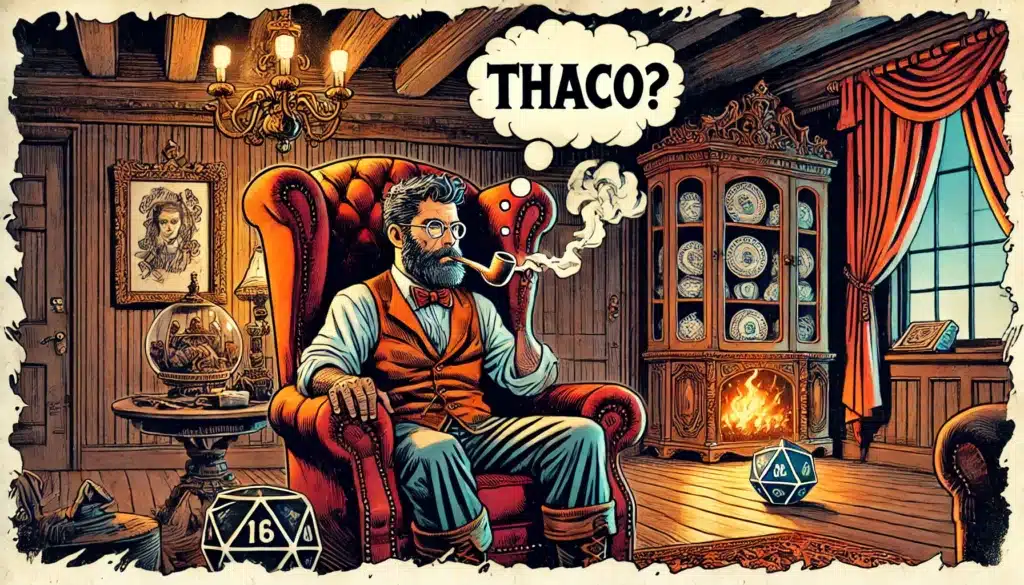
Making the Most of Player Input
Player-driven storytelling thrives in a no-prep environment. Every backstory, wild speculation, or offhand observation can fuel the next big moment. Instead of treating player quirks as distractions, bring them into the fold: if someone jokes about a mysterious bakery cult, why not make it the centerpiece of the session’s intrigue? When players offer up theories, test them—they’ll feel clever if their suspicions prove right, and invested when the world acknowledges their impact.
This style of play means relinquishing control, but in the best way. Listen not just for what players want, but also for their unspoken excitement. Did a paladin’s player drop a hint about family secrets? Weave those secrets into the politics of the next town. Does the wizard’s spell selection suggest a deep curiosity about ancient ruins? Drop a fragment of mysterious history that only they can decipher. This validation makes players feel seen and makes the world feel rich and reactive.
Let the party’s actions—and even their mistakes—shape the broader narrative. If a party member befriends a nameless NPC, give that character a role to play later. If a single dice roll changes the fate of an innocent, let those consequences echo. The trick is being generous with spotlight moments without scrambling your core logic. Turn interesting solutions, bold moves, or even misfires into opportunities for new scenes, challenges, or relationships.
By being attentive and reactive, DMs foster a virtuous cycle of engagement. Players notice when their efforts ripple outward and will meet you halfway in building up plots, adversaries, and mysteries. The best sessions are those where everyone, DM included, finds themselves surprised by what grows from the seeds planted in each other’s imaginations.
14+ Ways to Turn Player Input Into Story Beats:
- Canonize in-game jokes as plot elements
- Make minor NPCs into returning cast based on player interest
- Base an entire subplot on a player’s dream or vision
- Decide a town’s fate on the outcome of a single roll
- Take player suspicions and make some of them true
- Let character backgrounds reshape local lore
- Reward risk-taking with new leads or discoveries
- Turn party moral debates into real in-world dilemmas
- Let failed skill checks create new complications
- Use player gear choices to inspire magical discoveries
- Have rumors reflect what the party has done
- Reintroduce old villains or rivals organically
- Interpret player “what ifs” as reality within the world
- Allow growing relationships to drive quest hooks
- Reference previous player heroics in local culture
Harnessing player input transforms your game into a rich tapestry woven from unique threads, each one holding the potential for magic. By actively inviting players to share their ideas, dreams, and visions for their characters, you cultivate an environment where everyone feels invested and validated. Encourage them to voice their desires and curiosities; a simple prompt like, “What’s your character’s biggest secret?” can spark a cascade of narrative possibilities, allowing you to incorporate their aspirations into the unfolding story. Every suggestion generates momentum, creating a shared narrative that surprises both you and your players, reinforcing the collaborative spirit at the heart of roleplaying. Additionally, remember that the beauty of co-created storytelling lies not only in embracing the unexpected but in recognizing the vibrant synergy that arises when players contribute. As the story unfolds, take a moment to celebrate their contributions—whether through humorous callbacks, narrative echoes, or meaningful character interactions. This validation strengthens the bond between you and your players, ensuring that each session is not just an adventure through a fantasy landscape but a shared journey, where all voices harmonize into a captivating narrative symphony. By diving into this collaborative mindset, you help keep the story alive, dynamic, and vibrantly engaging for everyone at the table.
Tools That Make It Easier
Even with zero prep, a few clever tools can grease the wheels of improvisation. Random tables—be they for encounters, NPCs, loot, or events—offer instant inspiration when ideas run dry. With the roll of a die, you can conjure a strange merchant, a sudden storm, or an ancient relic with just enough detail to send the story spiraling in a new direction. These tables become a wellspring for creativity, populating the game world without demanding hours of prior thought.
Modular maps and tiles can be lifesavers, providing just enough structure to keep things grounded. A few versatile dungeon geomorphs or index cards with location names enables you to layout a tavern, hideout, or wilderness area at a moment’s notice. There’s no pressure to have a perfectly mapped-out town; rough sketches and versatile props help you pivot when the party zags instead of zigs.
⚔️ Fantasy RPG Random Tables Books
Make life as a Gamemaster easier…
If you play Dungeons & Dragons, Pathfinder, or other fantasy RPGs, this
RPG random tables series
is packed with encounters, NPCs, treasure, and more. Available in eBook or print—either way, you’ll have a wealth of adventure ideas at your fingertips.
Simple note systems round out the toolkit. As you improvise, jot down important NPC names, locations, and plot threads in short bullet points. This living document prevents important details from slipping through the cracks and lets you maintain consistency as the tapestry of the world weaves itself around player actions.
| Tool Type | How to Use On the Fly | Improv Benefit |
|---|---|---|
| Random Encounter Table | Roll to populate scenes as needed | Instant inspiration |
| NPC Name List | Pick or roll a name for new characters | Speed, consistency |
| Modular Map Tiles | Quickly assemble locations | Flexible environments |
| Plot Hook Generator | Grab a quest or complication in a pinch | Fresh story beats |
| Improv Monster Cards | Assign stats/traits to foes instantly | Balanced encounters |
| Index Cards | Record key NPCs and clues | Easy tracking |
| Setting Vignettes | Use short blurbs for locations or events | Quick worldbuilding |
| Dice-Driven Tables | Let randomness dictate minor events | Surprising twists |
| Evernote/Note-taking App | Log session highlights on the go | Continuity for future play |
| Generic Prop Items | Hand out tokens/objects for immersion | Added focus and engagement |
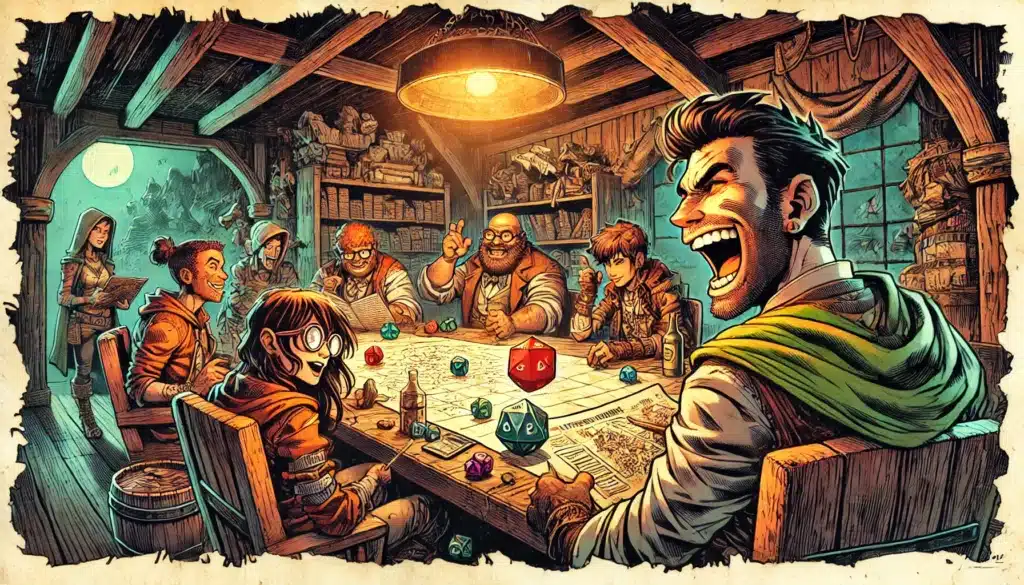
Structuring the Session Mid-Game
Without a roadmap, pacing and structure become a dance you improvise in real time. Look for natural act breaks—moments of high drama, humor, or discovery that serve as narrative milestones. This helps break up the session into digestible segments. Recognize when tension is rising: a quietly sinister hint, a brewing rivalry, or an imminent threat can all signal that stakes are escalating and that the next scene could mark a turning point.
Pay close attention to the energy at the table. If players are flagging, introduce a ticking clock or pressing event. This could be a literal countdown, like an erupting volcano or approaching army, or something personal, such as a rival showing up at the worst possible moment. Conversely, give space for downtime or character bonding when excitement peaks and needs to cool off. Knowing when to ramp things up or slow them down is an improvisational art form.
Satisfying scene conclusions are possible even with no script. Bring narrative arcs to a head by rewarding bold actions, echoing earlier choices, or unveiling new mysteries right as the party accomplishes a goal. Use thematic callbacks to wrap up storylines or to suggest larger dangers lurking in the background. Every resolved thread can become fertile ground for another problem or promise down the road.
Ultimately, structuring an improvised session means treating every moment as a potential crossroads. Each decision, each dramatic reveal, and each unexpected twist spins off into further possibilities. Guide the table’s energy with gentle nudges, responding to cues rather than enforcing beats, and you’ll find your games flow with an organic storytelling logic all their own.
13+ Ways to Build and Escalate Narrative Arcs in Real Time:
- Introduce a ticking clock scenario
- Use player assumptions as foreshadowing
- Evolve threats based on party fears
- Tie subplots together with chance meetings
- Escalate conflicts as stakes grow
- Refresh the tension with surprising betrayals
- Bring back unresolved mysteries
- Let consequences build upon earlier choices
- Reveal hidden motives of NPCs as the session progresses
- Shift allegiances or alliances suddenly
- Add environmental changes to signal arc shifts
- Provide recurring symbols or motifs
- Give characters personal stakes in unfolding crises
- Use dramatic entrances and exits for pacing
- Drop hints about larger, world-spanning events
Ultimately, structuring the session mid-game is about attuning yourself to the rhythm of your table. By staying observant and responsive, you can guide each moment into something unexpected and impactful. Celebrate the magic of interactivity, where the narrative dances in sync with the players’ choices, and remember that the path is often more rewarding than the destination. Embrace the chaos, nurture the energy, and let the story unfold in its own beautiful, unpredictable way—because at the heart of no-prep D&D lies a vibrant tapestry woven from each player’s input and imagination.

Pitfalls and How to Avoid Them
No-prep gaming is not without its hazards. One major pitfall is inconsistent tone—shifts from grim horror to slapstick comedy can feel jarring if not handled with care. Maintain a sense of the overarching mood, and course-correct gently if scenes begin to clash. Underdeveloped characters or world details can also leave the experience feeling hollow. Combat this by seizing opportunities to flesh out personalities and settings on the fly, even if just with a striking trait or memorable quirk.
Try my AI Tabletop RPG generators...and an extensive library of content!
Aimless wandering, where players lack direction or motivation, is a common trap. Avoid this by planting dynamic goals—rewards, rumors, or personal stakes—whenever momentum slackens. Contradictory worldbuilding can also creep in as details are improvised out of sequence. Keep a running note of what’s been established, and be ready to retcon sparingly if continuity hiccups occur.
Setting clear but flexible boundaries keeps the game focused. Players thrive within a world that feels both alive and grounded. Provide enough context and stakes to give choices weight, but let the narrative adapt to their decisions instead of penning them in. If all else fails, be transparent about the improvisational nature of the session—this tends to buy a little grace from everyone when minor continuity gaps arise.
Finally, resist the temptation to fall back on repetitive encounters or overused tropes as a crutch. A steady diet of random fights or “you meet another mysterious stranger in a tavern” can quickly dull the magic. Stay curious and use the unique voices at your table to elevate the game beyond generic filler. With attention and creativity, most pitfalls can be avoided or even turned into assets.
12+ Common No-Prep Traps and How to Sidestep Them:
- Inconsistent tone—set and uphold a core mood
- Forgetting key NPC names—keep a running list
- Contradictory lore—note major facts as they emerge
- Underdeveloped characters—add quirks and motives immediately
- Aimless wandering—offer fresh hooks or goals
- Over-reliance on combat—vary encounter types
- Too many unresolved threads—tie up or revisit plot lines
- Losing track of party goals—recap objectives regularly
- Letting downtime drag—prompt with new dilemmas
- Ignoring player agency—celebrate their impact on the world
- Neglecting to escalate stakes—ramp up complications gradually
- Falling back on clichés—embrace unique, table-driven ideas
Navigating the landscape of no-prep DMing is as much about awareness as it is about creativity. By recognizing potential pitfalls and actively working to mitigate them, you empower yourself to create a dynamic and engaging experience. Embrace the unpredictability of your players’ choices, be willing to adapt, and stay attuned to the tone and direction of the story. With each session, you’ll refine your ability to ride the waves of improvisation, transforming potential missteps into opportunities for growth and innovation. Remember, the journey through no-prep D&D is not just about avoiding pitfalls; it’s about fostering an environment where creativity thrives, collaboration flourishes, and every story—whether chaotic or structured—becomes a cherished memory.
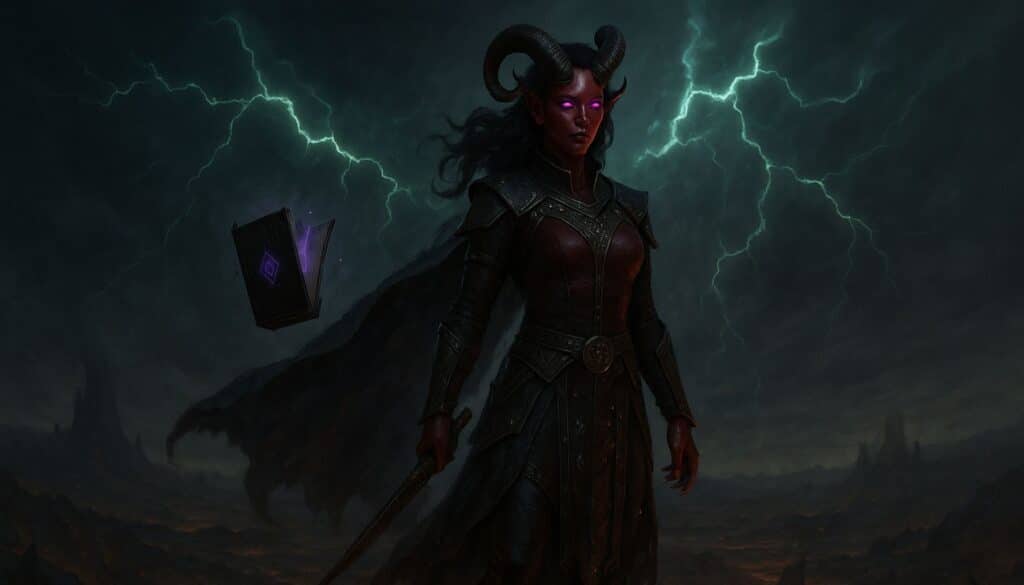
When to Cheat Just a Little
There’s no shame in a few backup cards stashed up your sleeve. No-prep doesn’t mean you must leap entirely without a net; it means keeping the structure light and your improvisational muscles limber. A handful of loose ideas—a list of evocative names, an old map, or a favorite conflict trope—can smooth out rough patches and let you focus on the spontaneous fun without scrambling for inspiration.
Think of these as scaffolding, not shackles. The point isn’t to run a canned adventure but to ensure you never feel completely adrift. Three quick NPC concepts, a clutch of random location descriptions, or a conflict triangle (three linked goals or rivalries) gives you just enough to riff confidently if momentum flags. Used judiciously, these “just in case” tools can help you pivot in trickier moments without undermining the spirit of improvisation.
These subtle support elements are invisible to players but invaluable to you. They act as a silent engine, quietly providing options so you can focus on listening, adapting, and surprising. The result feels effortless—and most importantly, the collaborative magic stays intact even if you rely on a little prep in your back pocket.
10+ Low-Prep Elements That Feel Spontaneous:
- Reusing an old map with a new spin
- Keeping three NPC names on hand
- Sketching a quick conflict triangle
- Having a random trinket or magic item table ready
- Carrying a list of location prompts
- Preparing several generic stat blocks for monsters
- Concealing one or two iconic town features for random use
- Noting three potential plot hooks in advance
- Stocking a deck of “weird rumors” for quick inspiration
- Creating rough relationship webs for party/NPC ties
- Drafting short village or dungeon descriptions
- Saving a couple of evocative music tracks or sound effects
Leaning into a few helpful hints or reference points can enhance your no-prep experience without compromising the spontaneity you’re aiming for. Think of these safety nets as your secret ingredients—sprinkling in just enough structure to elevate the narrative without overshadowing player creativity. Remember, the goal isn’t to pre-script every moment but to create the space for magic to unfold. By maintaining a balance between improvisation and these subtle supports, you can foster a lively atmosphere that encourages innovation, surprise, and shared joy. The beauty of no-prep play lies in its unpredictability; a little preparation can go a long way in ensuring that the unpredictable remains thrilling and cohesive, allowing you to embark on adventures that are as memorable as they are fluid.

No-Prep Campaigns vs One-Shots
No-prep play wears different masks in short and long-term settings. One-shots, by their nature, thrive on immediacy. You can push the boundaries, bring wild ideas to the table, and resolve plotlines in quick order. There’s less pressure to maintain perfect continuity, so you can let chaos reign and see what unexpected stories blossom in a single session.
Campaigns, in contrast, demand a touch more care. Character growth, narrative consistency, and worldbuilding accumulate weight as sessions stack up. You might need to be more deliberate in weaving together recurring motifs, stitching old NPCs into new storylines, and ensuring that evolving stakes make sense over time. Improvised campaigns are about both invention and gentle curation.
Pacing also shifts by format. One-shots encourage breakneck action, with arcs rising and falling within a few hours. Campaigns benefit from measured beats, where quieter character-driven moments can breathe. In either case, no-prep DMs find new joys by letting the campaign world blossom around player decisions instead of ahead of them.
Falling back on a few spare elements—a map, key names, unresolved mysteries—can be a lifesaver in both formats, but the ratio and intent differ: in one-shots, it’s all fuel for the fire; in campaigns, it’s a safety net for the long journey.
| Aspect | One-Shot No-Prep | Campaign No-Prep | Shared Elements | Prep Fallback Needs |
|---|---|---|---|---|
| Challenge Type | Immediate, punchy | Evolving, layered | Player-driven decisions | Modular ideas or tools |
| Pacing Style | Fast, dramatic | Alternating tempo | Scene-based structure | Spare names, maps |
| Emotional Stakes | Intense, explosive | Gradual, cumulative | Responsive to actions | Flexible frameworks |
| Narrative Continuity | Minimal needed | Must track growth | Callbacks, recurring NPCs | Session notes/tracking |
| Worldbuilding | Only essentials | Fills in over time | Collaborative invention | Minimal scaffolding |
| Player Buy-In | Focused, high energy | Sustained engagement | Shared creative ownership | Ready hooks/rumors |
| Plot Resolution | Complete by end | Ongoing, unresolved | Quick improvisation | Tie up loose ends |
| Surprise Factor | High per scene | High per arc | DM also surprised | Recap/prior session aid |
The choice between no-prep campaigns and one-shots hinges on your storytelling goals and the dynamics at your table. One-shots shine with their exhilarating spontaneity, where every moment is a chance for innovation, experimentation, and instant payoff. They afford a unique thrill as players dive headfirst into a narrative whirlpool, knowing they’ll emerge with a complete tale in a single sitting. Campaigns, on the other hand, invite sustained exploration and depth, creating a tapestry woven from multiple threads of player actions, character development, and evolving plots over time. Each format has its charms, allowing you to adapt your improvisational approach to suit the desired play experience. Whether you’re crafting a concise adventure or embarking on a prolonged journey, embracing no-prep principles in either setting fosters a vibrant space for unexpected narratives to flourish, ensuring every session—regardless of length—holds the potential for unforgettable stories.

Final Thoughts on Running With Chaos
When you strip away the layers of premeditated planning, what’s left at the table is pure, unfiltered adventure. No-prep D&D isn’t an abdication of responsibility; it’s an act of trust—a leap of faith into the nebula of shared imagination. Not every twist will land, and not every improvisation will become the stuff of legend, but each moment is alive, electric with possibility.
Most games do not require a masterfully orchestrated plot to transport players into realms of wonder. The immediacy of mutual discovery, the thrill of a world conjured together in real time, can rival months of careful design. Trusting your instincts and responding honestly to your group is an invitation to moments that genuinely surprise and delight.
Shared creativity is the secret heart of roleplaying. As a DM, the greatest stories will often grow not from a page in your notebook, but from the wild, irreverent, heartfelt ideas tossed out by your players. By embracing chaos, by being willing to throw your own plans out the window and let them write the world with you, you unlock a style of play that never gets old.
⚔️ Fantasy RPG Random Tables Books
Make life as a Gamemaster easier…
If you play Dungeons & Dragons, Pathfinder, or other fantasy RPGs, this
RPG random tables series
is packed with encounters, NPCs, treasure, and more. Available in eBook or print—either way, you’ll have a wealth of adventure ideas at your fingertips.
If you find yourself burned out, frustrated, or simply stuck in a rut, consider running a no-prep session for your group. Trust your table, trust your instincts, and see what you can build together from the raw material of chaos and laughter. Magic doesn’t live in the margins of a spreadsheet; it lives in the living, breathing connection between players and DM.
In the end, chaos is not the enemy—it’s the canvas. With every unscripted twist, every unexpected triumph or disaster, you and your group create something wholly unique. Don’t shy away from the unknown. The reckless bravado of no-prep DMing just might lead you to the most memorable adventures of all.

